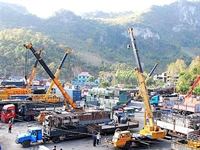
| Economy shows positive signs | |
The country continued with its rapid economic recovery in the first half of this year with positive trends in two key economic indicators, gross domestic products (GDP) and the consumer price index (CPI), reported the Ministry of Planning and Investment (MPI). In the first six months, GDP grew from 6 to 6.1 percent. In the first quarter the country’s GDP rose by 5.83 percent and then by 6.2 percent in the second quarter, the CPI rose 0.22 percent in June compared to the previous month. All sectors achieved growth rates higher than the same period last year. In particular, agriculture, forestry and aquaculture grew from 2.7 to 3.2 percent, industry and construction increased from 6 to 6.7 percent, and services rose from 6.8 to 7.2 percent. A number of factors that support growth have contributed to these upward trends. Developing of the investment environment helped to triple industrial production last year and many improvements to meet consumer demands and exports have also been introduced. An estimated 36.5 percent of the investment capital allocated by the State for the year was used by May. The amount of capital disbursed through official development assistance channels was also higher than the same period last year. On top of this, the country’s outstanding national loans as of May 31 rose by 7.5 percent against last December. During the first six months of the year, foreign investment reached US$8.43 billion in registered capital, with FDI disbursements reaching US$5.4 billion, according to the Foreign Investment Agency. The Ministry of Industry and Trade reported that the output of most key industrial products picked up in the first half of this year. Oil output surged by more than 7 times, liquefied gas more than doubled, the sales of air-conditioners rose by 46 percent and that of machine tools by 45 percent. In June, the pharmaceuticals market has been farily stable. The cost of medicines in public clinics and retail stores has been generally lower than in private chemist’s shops, according to the Ministry of Health. They added that that the continued heat wave would bring on diseases and increase the demand for medicines and treatment. However, a stable drugs supply will help to stabilise the market. | |
| Vninfogate.Com |
